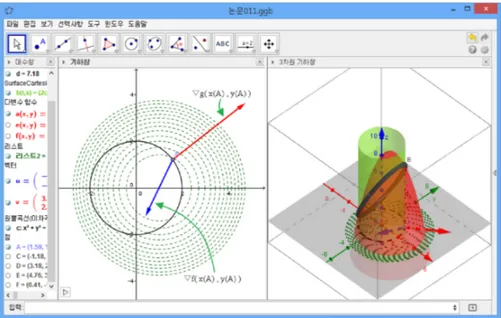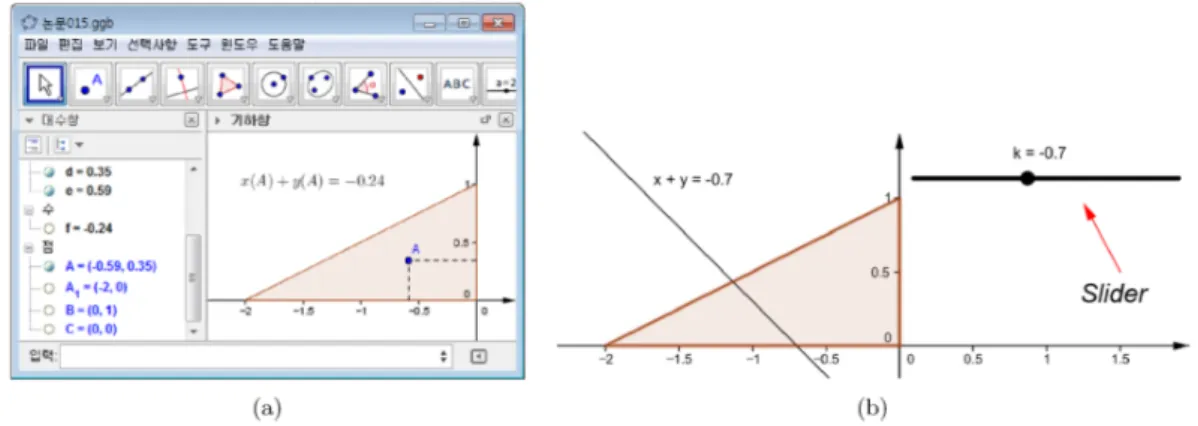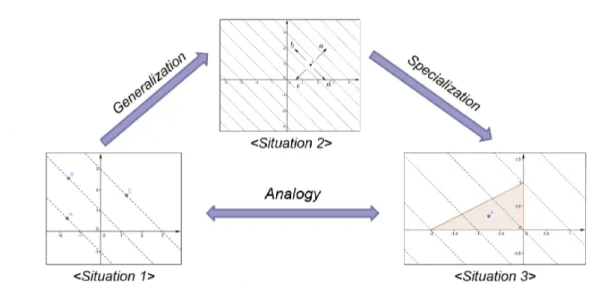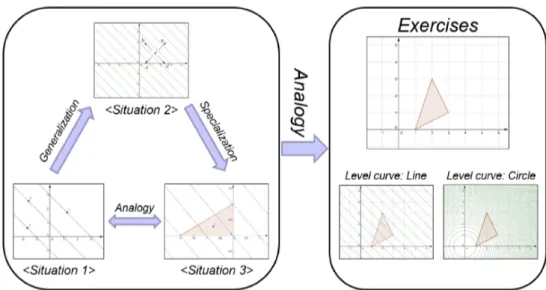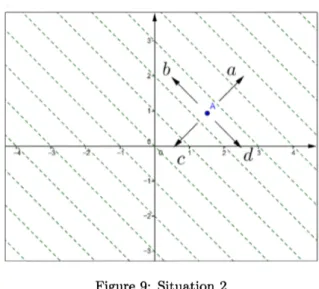A
Study
on
teaching and learning problem-solving of the
optimization problems in regional inequalities using
GeoGebra
Kyeongsik
Choi
Sejong Global
High School,
Sejong, Korea
Abstract
This research isconductedto develop teachingandlearningmaterials for problem-solving of the
optimization problems inregionalinequalities usingGeoGebra. Intheresearch, thethree situations
weredeveloped according to the three steps which Polya suggested, inductionandanalogy,
generaliza-tionandspecialization. The materialsdevelopedwereprovided to studentsatthe privateinterviews.
At the interviews, students used the thinkingwaywhich Polya suggestedforproblem-solving. Plus,
completing the questionnairewas required to the students aftersmall groupclasses: Students
pre-ferred that infinitelymany levelcurves weredrawnon the plane instead ofonelevel curvefor their
problem-solving. Also, GeoGebrawasuseful for themto observeinfinitelymany levelcurvesandthe
change of$f(x, y)$ofapointon theplane.
1
Introduction
According to National Council of Teachers of Mathematics (2000), computer
can
make students expressvisually mathematical concepts, analyze data, and get broader mathematical experience. In National
Education
Curriculum
2009
of Korea, using technology tools is recommended for understanding concepts,principles of mathematics, enhancing problem-solving ability and evaluating complex calculation. For
making math teachers
use
technology tools for teaching math in their classrooms, proper teaching andlearning materials should be provided. Current math textbooks, however, have only
one
or
two pagesrelated with how to
use
technology tools for teachingor
learning mathematics with them in the endof every chapters and most of Korean math teachers don’t teach this content. On top of that, many
materialsdeveloped previously cannot be used in these days, for currenttechnologyhave beendeveloped
and
overcome
many defects ofprevious educational materials using technology. Teaching and learningmaterials using technology should benewlydeveloped againwith recent technology.
Inthis research, previous researches about developing teaching and learning materials for
problem-solvingof theoptimization probleminregional inequalities
were
investigated anddevelopingnew
materialswith GeoGebra,whichis
a
dynamic mathematics software,was
conducted. Indevelopingmaterialsusingtechnology, making students concentrate not how to
use
GeoGebra, but how to solve problemswas
considered. Students didn’t learnhow to
use
GeoGebra in detail. Instead, they tried to solveproblems,and then used GeoGebra for using it
as
a
toolfor problem-solving.2
Theoretical
Background
P\’olya (1954) thought Generalization, Specialization and analogy
as
important properties forproblem-solving. Polya explained the three properties, Generalization, Specialization andAnalogyinthe
problem-solving processin Figure 1. The right triangle ofI is separated by the height from the hypotenuse in
II. The relation between I and II is analogy. III in Figure 1 is the generalization of I, and II is the
specializationof III. In this process, the strategies forproblem-solving, generalization, specializationand
analogy,
can
make students have much broader thought and get to know how to prove Pythagoreantheorem.
WhileP\’olya (1954)discussed theplausible reasoning, he proposed
an
exampleof theoptimization ofregional inequalities for thethought strategy.
数理解析研究所講究録
Figure 1: Generalization, Specialization, Analogy(Polya)
Given two pointsand
a
straight line, all inthesame
plane, bothpointson
thesame
side oftheline. On the given straight line, findapoint from which thesegmentjoining thetwogiven
pointsis
seen
under thegreatest possible angle(P\’olya, 1954).$l$
(a) (b) (c)
Figure2: Tangent level
curve
forproblem-solvingthe maximumproblemIn Figure $2a$, the problem means to find the position where the angle can be maximized looking
segment $AB$ atpoint X
on
line$l$.
If there isa
point$C$whichhas
$x$ coordinateas
$x$coordinate ofpoint$X,$$y$
coordinate
as
thevalue
of angle, the trace of point $C$seems
like Figure$2b$.
Thus, the intersectionpoint between
a
segment $AB$ anda
line$l$ is the placewhere the size ofangle is $0$; if thepoint $X$moves
tothe right infinitely, the sizeof angle will converge $0$again. Therefore, there ispoints which
can
havethe
same
angle value, for the two end of this ray is(almost) $0$ and thesize ofangleisalways positive andchanges itssizecontinuously. InFigure$2c$, point$X$and $X’$havethe
same
size of angle,becausepoint$A,$$B,$ $X,$ $X’$
are
on
thesame
circle. According the previous observation,thepoint for the maximum valueofangleshould be the only
one.
Therefore, point$A,$ $B,$ $X$should beon a
circle and the circle should bea
tangent line to the line $l.$In the curriculum, there
are some
examples ofthe optimization with the concept of ‘tangent levelcurve’. The first example is
a
multi-variable problem.Figure
3:
Lagrange’s multiplier andtangent levelcurve
$f(x, y)=9-(x-1)^{2}-y^{2}.$
Generally, Lagrange multiplieris used for solving this problem. Thus, the equations for solvingthis
problem
are
as follows:$\nabla f(x_{0}, y_{0})+\lambda\nabla g(x_{0}, y_{0})=0$
$g(x_{0}, y_{0})=0$
Figure3represents the proposed problem situationas$2D$and$3D$
.
The levelcurves
in$2D$ figureshowsthe height from$xy$ plane and the line isdomain offunction. Also, there
are
the two vectorsof point $A,$$\nabla f$ and $\nabla g$ in Figure3. $\nabla f(x_{0}, y_{0})+\lambda\nabla g(x_{0}, y_{0})=0$
means
that thetwo gradientsare
parallel and thelevel
curve
for getting themaximumor
minimum should be tangent to the domaincurve.
The second examplefor evaluating maximumand minimum is the optimization problem in regional
inequalities
as
follows:Intheintersectionregionof$x\geq 0,$ $y\geq 0,$$2x+y\leq 6$,evaluate themaximumand theminimum
of$2y-x.$
InFigure4,there
are
manylevelcurves on
theCartesianplane. According to the property of‘tangentlevelcurve’,the level
curve
should meet theonlyonepointto theregion.3
Previous Researches
Seo (2009) pointedthat many students learn the algorithmic method forsolvingtheoptimization problem
inregion inequalities and studentshave
some
difficulties for understanding the mathematical principles.Thus,Seo (2009) proposed that students should recognize the exact meaningofthe problem:
1. evaluatingthe max-min value of function ofpoints in domain
2. using the fact that domain ispartitionedbythe level
curves
forsolving max-min problemFigure4: The optimization problem in regional inequalities and tangent level
curve
Lee (2012) developed teaching and learning materials for helping students solve the optimization
problem using GeoGebra’s features, coordinate functions, function graph, slider tool. Lee applied the
materials to her students and help them understand the meaning of $f(x, y)=k$, the relation of the
variable $k$and the level
curve
$f(x, y)=k.$Lee (2012), however, found that
some
unintentional pedagogical changes by theuse
of technologytools:
1. If students used coordinatefunction, theycould get function value at everypoint easily.
However, this made studentsrecognizethenecessity ofusingthe level
curves
forsolvingthe optimization problem(Figure$5a$).
2.
If students used the slider tool for solving the problem, students could get the value ofthe slider$k,$ $k$-level
curve.
However, this made students forget theexact meaning oftheproblem, evaluatingmax-min value of the function at points,the method ofcalculating
thepoint’s coordinate tothe function(Figure$5b$).
(a) (b)
Figure5: Lee(2012)’s teaching and learning materials for the optimization problems
When the technology tool is used forteaching and learning materials, thealternative way should be
resolved. In this research, teaching and learning materials using
GeoGebra
without the unintentional$<$
Situation
f$>$ $<$Situation
3
$>$Figure6: The process forproblem-solvingtheoptimizationproblem(I)
4
Developing teaching and learning materials
In thisresearch, thematerials
were
developed forsolving the problemas
follows:If
a
point $(x, y)$ is in the intersection ofthree region: $x\leq 0,$ $y\geq 0,$ $x-2y\geq-2$.
Evaluatethe maximumand minimum of$x+y.$
For solving this problem, the first step is tounderstand the concept of the level curves(Lee, 2012). In
generalmathtextbooks,$k$-level
curve
for$f(x, y)=x+y$andthe method ofchanging$k$-value isproposed.In thisresearch, thematerials
were
developedusing the threeproperties: generalization, specializationandanalogy.
Situation
Iprovidessome
questions, whichhave activities for understanding the propertiesof
a
pointon a
levelcurve
withGeoGebra’s coordinatefunctions, for students to makean
inference aboutthe concept of level
curves
inductively. Situation 2, the generalization of situation 1, providea
pictureand
some
questions to explore the changing ofvaluealong the movement ofa
point. From situation 2,students may understand that the plane is partitioned by infinitely many level curves(lines). Situation
3, the specializationof situation 2, provide activities about getting the maximum andminimum values
of$f(x, y)$ in regional inequalities(Figure 6, Figure 7).
5
Discussions
In this research, three interviewees
were
participated and they had learned the problem-solving theoptimization problem with
a
teacher.All students answered the questions of situation l(Figure 8), but
a
student didn’t know the exactreason
for theanswer.
Teacher askedof
thequestionagain to thestudent,and the student triedto
thinkoftheproblem again.
la Teacher: Looking point $A,$ $B,$ $C$
on
the lines, how much is thesum
of$x$ and$y$coordinatevalue ofpoint$B$?
lb Teacher : Can you guess the value?
2 Sl: No, it isnot accurate.
3 Teacher: No. It is not accurate. Bytheway, youdo something?
4 Sl : Um,
are
you askingthe coordinate of this point?Figure
7:
Theprocess
for problem-solving the optimization problem(II)Figure9: Situation 2
5 Teacher: Yes,$x$coordinate and$y$coordinate. Howmuchisthe
sum
of$x$and$y$coordinate value ofpoint $A$?
6
Sl : This questionasks of$x$ and$y$of thisequation.7 Teacher : No. This question
means
$x$ coordinate and $y$coordinate ofpoint $A.$8
Sl: Ah9 Teacher: Isn’tit?
10
Sl: Ah, it is. I misunderstoodSituation 2 is thegeneralized
one
ofSituation
1. InSituation 2, students couldexpect thechange of$f(x, y)$’s value according to
a
point which couldmove
freelyon
the Cartesianplane. At $44b$, Sl couldguess the value of$f(x, y)$ accordingtothe point’s coordinate usinglevel
curves
ofSituation
1.41 Teacher: The point, which direction will make the valueto increase? Thefirst question..
$42a$ Sl : Direction $a$will make the valueincresing.
43
Teacher: Uh,Why?$44a$ Sl : Um, just before, just
a
minute. CanIsee
the previous thing(Situation 1)?$44b$
Sl
: According tothis, here is $-1$.
When$x+y$is 1, here. When$x+y$ is 3, here. $44c$ Sl : Therefore,they ismovingto upwardas
the number is growingbigger.$44d$ Sl : So, if$x+y$is growing bigger, it(point) will
move
this direction.Situation
3
is thespecializedone
ofSituation 2. In Situation 3, students could get to know themax-min valuesof$f(x, y)$ with the pointin theregion provided. At 47, Sl couldexpect$49a$ using theresult
which
was
observed in Situation$2$ like4$7.$45 Sl : If it(point)
moves
this direction, the value won’t be changed.46
Teacher: Um.Figure 11:
Situation 3
$t*t_{-}/g\eta]$
$1.*\alpha\S \mathfrak{g}qq_{k|s+v^{9j}}\triangleleft ast\approx\#\mathfrak{B}*w*.$
.
$)$く.$$\check{}$1..I $W,$$\zeta t.0\backslash$
en
ZZCtSt$r.$$\alpha\wedge\# 8$qq$\wp q$ayql$\lambda$I$$\mathfrak{g}$kl$O|ff*\triangleleft \mathfrak{g}*\wedge\Re.$$f.\sim\backslash Y\wedge\sqrt{}r\sim\tau$
47
Sl: Bythe way,justbefore you said I saidjust before, this way makes the value increasing, thatway makes the value decreasing.
48
Teacher: Decreasing.$49a$ Sl : So,the point
can
move
only in thisfigure, the most downwardpart isthis.$49b$ Sl: So, this value is thelowest, the toppart ofthis ispoint A.
Solvingexercises,students could expect the change of$x+y$’s value usinglevel
curves
as
the auxiliarytoolfor thinkingbythemselves with GeoGebra.
At thequestionnaire
survey,
students answered that many levelcurves
drawnon
theCartesian
planewere
more
helpful to solve theproblemthan the onlyone
levelcurve
on
theplane. Moreover,GeoGebra
was
useful to draw graph of function and effective to solve problems andunderstand
mathematicalprinciples.
6
Result
For teaching mathematics using technology tool in school, topics which
can
be helpful for students tosolve problems should be chosen. Teachers also should guide to get proper mathematics concepts and
enhance problem-solving ability.
The objective of this research is to develop teaching and learning materials which
can
be used forteaching problem-solving using GeoGebra. Especially, the three situations along the three strategies,
generalization, specialization and analogy,
were
developed and applied toa
few students for teachingproblem-solving ofthe optimization problem in regional inequalities. Studentsin this researchunderstood
the idea of level
curves
for
solving the optimizationproblemand usedGeoGebra
tojustify theirhypothesis.It is worth
to
be expected that researchesrelated
with this research shouldbe
investigated aboutproblem-solving with technology tool.
References
Lee,S. (2012). AStudy
on
Learning and Teaching of the optimization Problems in Regional InequalitiesUsing
GeoGebra.
Master’sthesis, Korea National University ofEducation, Korea.National Council of Teachers of
Mathematics
(2000). Principles andStandardsfor
School Mathematics.Reston, $Va.:$
NCTM.
P\’olya,G. (1954). Mathematics andplausible reasoning: Induction and analogyinmathematics, volume1.
Princeton
UniversityPress.Seo, H. (2009). Astudyabout teaching inthe
area
ofInequality: Aproblem ofmaximum and minimum.Master’s thesis, Seoul National University, Korea.

